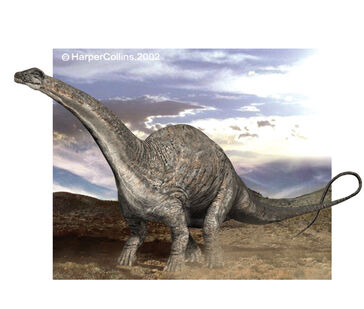Apatosaurus/Brontosaurus was one of the largest land animals that ever existed. The dinosaur Brontosaurus is now called Apatosaurus. It is one of the most well-known dinosaurs.

Description[]
This enormous plant-eater measured about 70-90 feet (21-27 m) long and about 15 feet (4.6 m) tall at the hips. It weighed roughly 33-38 tons (30-35 tonnes). Its head was less than 2 feet long; it had a long skull and a very tiny brain. This plant-eater had a long neck (with 15 vertebrae), a long whip-like tail (about 50 ft = 15 m long), a hollow backbone, peg-like teeth in the front of the jaws, and four massive, column-like legs. Its hind legs were larger than the front legs. Fossilized Apatosaurus footprints (called trackways) have been found (in Colorado, USA) that were about a yard wide.Apatosaurus could have held its head at most 17 feet (5.4 m) off the ground (Parrish and Stevens,1999). Allosaurus, which was the biggest meat-eater at that time in North America, was only 15 feet (4.6 m) tall. This afforded Apatosaurus protection from predators, since carnivores like Allosaurus couldn't attack its head or neck, and probably had more sense than to attack its gigantic, clawed feet or whip-like tail.All though not as tall as some of the other Sauropods, it was was one of the heaviest. Strangely, Apatosaurus' nostrils were located on the top of its head. No one is sure what purpose this served. It used to be thought that this was a snorkel-like device for a water-dwelling animal, but this theory has been repudiated. Since Apatosaurus fossils have been found far from any water-dwelling fossils, it is now believed that Apatosaurus spent most of its time on land, far from large bodies of water or swamps.Apatosaurus held its neck more-or-less horizontally (parallel to the ground). The long neck may have been used to "mow" wide swaths of vegetation or to poke over or into stands of trees to get foliage that was otherwise unavailable to the huge, lumbering varieties of sauropods who could not venture into forests because of their size. Alternatively, the long neck may have enabled this sauropod to eat soft pteridophytes (horsetails, club mosses, and ferns). These soft-leaved plants live in wet areas, where sauropods couldn't venture, but perhaps the sauropod could stand on firm ground and browse in wetlands.
Although many [[|sauropods]] may have traveled in herds, bonebeds of Apatosaurus fossils have not been found.It may have been a solitary animal.
Sauropods' life spans may have been on the order of 100 years.Apatosaurus, like other sauropods, hatched from enormous eggs up to a 1 foot (30 cm) wide. Sauropod eggs have been found in a linear pattern and not in nests; presumably the eggs were laid as the animal was walking. It is thought that sauropods did not take care of their eggs.
This huge, extremely heavy reptile was an herbivore (it ate only plants, like conifers, other tree leaves and ferns). It must have eaten a tremendous amount of plant material each day to sustain itself. Apatosaurus must have spent almost all of its time grazing. It had blunt pencil-like teeth, arrayed like a garden rake; these were useful for stripping and gathering foliage. According to paleontologist Robert Bakker, Apatosaurus may have had thick, moose-like lips that would help in gathering plant material.
Apatosaurus swallowed leaves and other vegetation whole, without chewing them, and had gastroliths (stomach stones) in its stomach to help digest this tough plant material.
Apatosaurus was named in 1877 by US paleontologist Othniel C.Marsh.It was called Apatosaurus, which means "deceptive lizard," because its fossils were so similar to those of other sauropods.The first relatively complete Apatosaurus fossil was found by Earl Douglass in the Morrison Formation (then called the Carnegie quarry) in Colorado, USA.
Popular Culture[]
Apatosaurus is a very popular dinosaur.It has appeared in many dinosaur-related books,movies and games.Some still call it Brontosaurus.